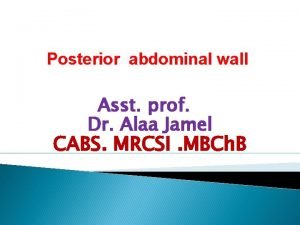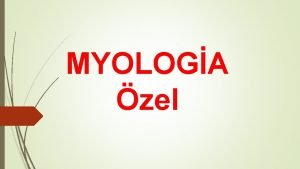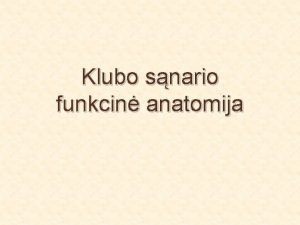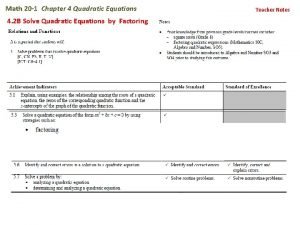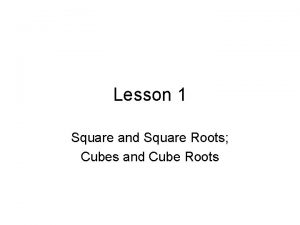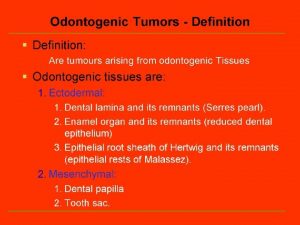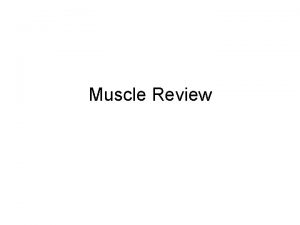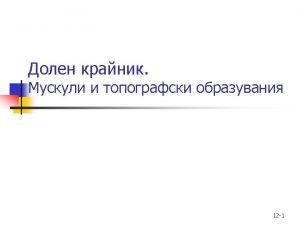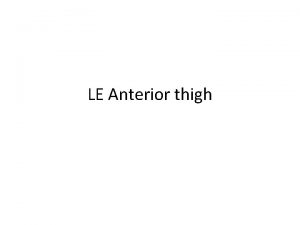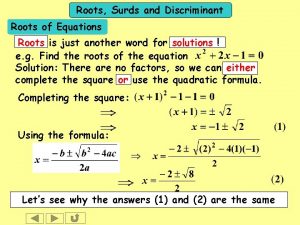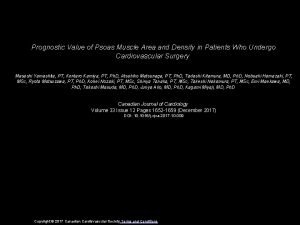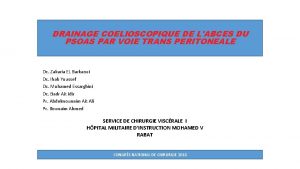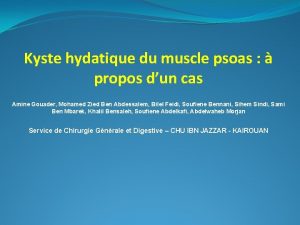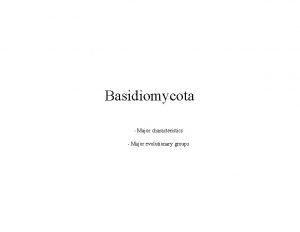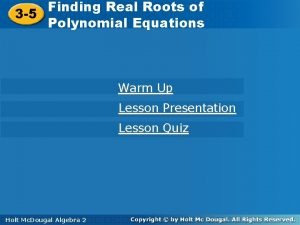Psoas Major It arises from the roots of





















- Slides: 21


Psoas Major It arises from the roots of the transverse processes; the sides of the vertebral bodies and the intervertebral discs from the 12 th thoracic to the 5 th lumbar vertebrae. Its fibers run downward and laterally and leave the abdomen to enter the thigh by passing behind the inguinal ligament. It is inserted into the lesser trochanter of the femur. It is enclosed in a fibrous sheath that derived from the lumbar fascia. This sheath is thickened above to form the medial arcuate ligament. Nerve Supply: femoral nerve and the ventral rami of L 1, 2, 3 ( lumbar plexus ). Action : it flexes the thigh at the hip joint on the trunk. If the thigh is fixed, it flexes the trunk on the thigh, as in sitting up from a lying position.

Quadratus Lumborum It is a flat, guadrilateral- shaped muscle that lies alongside the vertebral column. It arises below from tips of the transverse processes of the lower lumbar vertebrae; the iliolumbar ligament and the adjoining part of the iliac crest. It is fibers run upward and medially. is inserted into the transverse processes of the upper lumbar vertebrae and the lower border of the 12 th rib. It Its anterior surface is covered by lumbar fascia which is thickened above to form the lateral urcuate ligament and below to form the iliolumbar ligament. Nerve Supply: Lumbar plexus only the ventral rami of L 2; 3 and 4 Action: it fixes or depresses the 12 th rib during respiration and laterally flexes the vertebral column to the same side.

Iliacus It is a fan shaped and arises from the upper part of the iliac fossa. Its fibers join the lateral side of the psoas tendon to be inserted into the lesser trochanter of the femur. The combined muscles are often referred to as the iliopsoas. Nerve Supply: Femoral nerve ( L 2; 3; 4 ) which is a branch from the lumbar plexus. Action: It flexes the thigh on the trunk at the hip joint. If the thigh is fixed, it flexes the trunk on the thigh.


Transversus muscle It is a thin sheet of muscle that lies deep to the internal oblique. Its fibers run It arises from the deep surface of the lower 6 costal cartilages ( interdigitating with the diaphragm ); the thoracolumbar fascia ; anterior two thirds of the iliac crest and the lateral third of the inguinal ligament. It is inserted into the xiphoid process ; linea alba and the symphysis pubis. Nerve Supply: Lower 6 thoracic nerves; ilioinguinal and iliohypogastric nerves.

Fascial Lining of the Abdominal Walls The abdominal walls are lined by one continuous layer of connective tissue that lies between the parietal peritoneum and the muscles. It is continuous below with a similar fascial layer lining the pelvic wall. Superiorly: Diaphragmatic fascia which covers the undersurface of the diaphragm. The transversalis fascia which lines the transversus abdominis muscle. The ilio- psoas fascia which covers the iliacus and psoas major muscles. The quadratus lumborum fascia which covers the quadratus lumborum muscle. It is the anterior layer of thoraco- lumbar fascia. The abdominal blood & lymph vessels lie within this fascial lining, whereas the principal nerves lie outside this fascia. The femoral sheath is a downward prolongation of this fascia around the femoral vessels and lymphatic for about 1. 5 inch ( 4 cm) into the thigh behind the inguinal ligament. The femoral nerve lies outside this fascial envelope.

Thoraco-Lumbar Fascia It forms a strong aponeurosis and laterally gives origin to the middle fibers of the transversus abdominis and the upper fibers of the internal oblique muscles of the abdominal wall. It is divided into 3 layers. 1 - The posterior layer extends from the sacrum upward to reach the lower part of the neck. It covers the back of the erector spinae muscle. It is attached to the lumbar spines. 2 - The middle layer passes medially to be attached to the tips of the transverse processes of the lumbar vertebrae. It lies in front of the deep muscles of the back and behind the quadratus lumborum muscle. 3 - The anterior layer passes medially and is attached to the anterior surface of the transverse processes of the lumbar vetebrae. It lies in front

Psoas fascia and Tuberculosis Tuberculous disease of the thoracolumbar region of the vertebral column results in the destruction of the vertebral bodies. Pus may spread laterally under the psoas fascia. From there, the pus tracks downward, following the course of the psoas muscle and appears as a swelling in the upper part of the thigh below the inguinal ligament. This abscess may be mistaken for femoral hernia.

Diaphragm It closes the opening between the thorax and the abdomen which is bounded by xiphisternal joint; the costal margin and the body of the 12 th thoracic vertebra. It is a muscular and tendinous septum. It is the primary muscle of respiration.

Diaphragm It is dome shaped and consists of a peripheral muscular part which arise from 3 parts A sternal part, consisting of small right and left slips arising from the posterior surface of the xiphoid process. A costal part, consisting of 6 slips that arise from the deep surfaces of the lower 6 ribs and their costal cartilages. A vertebral part, arising by means of vertical columns or crura and from the arcuate ligaments.

The right crus arises from the sides of the bodies of the first 3 lumbar vertebrae and the intervertebral discs. The left crus arises from the sides of the bodies of the first 2 lumbar vertebrae and the intervertebral disc. Lateral to the crura the diaphragm arises from the medial and lateral arcuate ligaments. The fibrous medial borders of the 2 crura are connected by a median arcuate ligament which crosses over the anterior surface of the aorta.

The medial arcuate ligament extends from the side of the body of the 2 nd lumbar vertebra to the tip of the transverse process of the 1 st lumbar vertebra. The lateral arcuate ligament extends from the tip of the transverse process of the 1 st lumbar vertebra to the lower border of the 12 th rib.

The diaphragm is inserted into a central tendon which is shaped like 3 leaves. The superior surface of the tendon is partially fused with the inferior surface of the fibrous pericardium.

Some of the muscle fibers of the right crus pass up to the left and surround the esophageal orifice in a sling like loop. These fibers appear to act as a sphincter and possibly assist in the prevention of regurgitation of the stomach content into the thoracic part of the esophagus.

When seen from side, the diaphragm has the appearance of an inverted J. The long limb extending up from vertebral column and the short limb extending forward to the xiphoid process.

As seen from in front, the diaphragm curves up into right and left domes or cupolae. The right dome reaches as high as the upper border of the 5 th rib and the left dome reach the lower border of the 5 th rib. The right dome lies at a higher level, because the large size of the right lobe of the liver. The central tendon lies at the level of the xiphisternal joint. The domes support the right and left lungs whereas the central tendon supports the heart. The levels of the diaphragm vary with the phase of respiration, the posture and the degree of distension of the abdominal viscera. The diaphragm is lower when a person is sitting or standing. It is higher in the supine position and after a large meal.

Opening in the diaphragm The aortic opening: It lies anterior to the body of the 12 th thoracic vertebra between the crura. It transmits the aorta; thoracic duct and azygos vein. Esophageal opening: It lies at the level of the 10 th thoracic vertebra in a sling of muscle fibers derived from the right crus. It transmits the esophagus; the right and left vagus nerves; the esophgeal branches of the left gastric vessels and the lymphatics from the lower third of the esophagus.

Caval opening: It lies at the level of the 8 th thoracic vertebra in the central tendon. It transmits the inferior vena cava and terminal branches of the right phrenic nerve. Other Openings: 1 - Greater; lesser and lowest splanchnic nerves pierce the crura. 2 - Sympathetic trunks pass posterior to the medial arcuate ligament on each side. 3 - Superior epigastric vessels pass between the sternal and costal origins of the diaphragm on each side. 4 - Left phrenic nerve pierces the left dome to supply the peritoneum on its undersurface. 5 - Neurovascular bundles of the 7 th to 11 th intercostal spaces pass into the anterior abdominal wall between the muscular slips of the costal origin of the diaphragm.

Nerve Supply: The motor nerve supply on each is from the phrenic nerve ( C 3; 4 and 5 ) only. The sensory nerve supply to parietal pleura and peritoneum covering the central surfaces of the diaphragm is from the phrenic nerve. So, pain is referred to the shoulder & lower part of the neck ( C 3; 4 and 5 nerves ). The sensory supply to the periphery of the diaphragm is from the lower 6 intercostal nerves. So, pain is referred to the thoracic & anterior abdominal walls ( lower 6 thoracic nerves ). Arterial supply: Phrenic arteries from the aorta & Branches from the intercostal aretries & musculophrenic and pericardiacophrenic arteries. Action: On contraction, the diaphragm pulls down its central tendon and increases the vertical diameter of the thorax.

Functions of the diaphragm 1 - It is the most important muscle used in inspiration. 2 - Muscle of abdominal straining: Its contraction help in raising the intra-abdominal pressure to evacuate the pelvic contents. 3 - Weight – lifting muscle: By rising intra-abdominal pressure, it will help support the vertebral column and prevent flexion. It assists the postvertebral muscles in the lifting of heavy weight. It is important to have adequate sphincteric control of the bladder and anal canal under these action. 4 - Thoracoabdominal pump: The descent of the diaphragm decreases the intra-thoracic pressure and at the same time increases the intra- abdominal pressure. This pressure change compresses the blood in the inferior vena cava and forces it upward into the right atrium of the heart. Lymph within the abdominal lymph vessels also is compressed and passed upward within the thoracic duct. The presence of valves within the thoracic duct prevents backflow.
 One major barrier to entry under pure monopoly arises from
One major barrier to entry under pure monopoly arises from Diaphram openings
Diaphram openings Paoas major
Paoas major M. quadriceps femoris origo insertio
M. quadriceps femoris origo insertio Psoas major synergist
Psoas major synergist Articulatio cotylica
Articulatio cotylica Sum of the roots and product of the roots formula
Sum of the roots and product of the roots formula Perfect square definition
Perfect square definition What's a perfect square
What's a perfect square Existence and uniqueness of square roots and cube roots
Existence and uniqueness of square roots and cube roots The roots of american imperialism economic roots
The roots of american imperialism economic roots Vanessa jason biology roots answer key
Vanessa jason biology roots answer key Buddhism
Buddhism Basis risk arises due to
Basis risk arises due to The law of increasing opportunity costs arises because
The law of increasing opportunity costs arises because Diagram of monopoly
Diagram of monopoly Hedging with forward contracts
Hedging with forward contracts The principal agent problem arises primarily because
The principal agent problem arises primarily because Translation exposure arises
Translation exposure arises Basis risk arises due to
Basis risk arises due to Idle time meaning in cost accounting
Idle time meaning in cost accounting Unicystic ameloblastoma
Unicystic ameloblastoma


